Lynx (Rheinmetall armoured fighting vehicle)
| Lynx | |
|---|---|
 Lynx KF41 as proposed for Australia's Land 400 Phase 3 project | |
| Place of origin | Germany |
| Production history | |
| Designer | Rheinmetall Landsysteme GmbH |
| Designed | 2015 |
| Manufacturer | Rheinmetall Landsysteme GmbH |
| Variants | family (outline details for IFV available) |
| Specifications | |
| Mass | 34 to 50 tonnes |
| Length | 7.22 to 7.73 m (23 ft 8 in to 25 ft 4 in) |
| Width | 3.6 m |
| Height | 3.3 m (turret top on IFV) |
| Crew | 3 + 6/8 |
| Armour | Steel armour with various appliques |
Main armament | Lance turret (KF31) with 30 mm Rheinmetall MK30-2/ABM or 35 mm Wotan 35 or Lance 2.0 turret (KF41) with 35 mm Rheinmetall Wotan 35 autocannon |
Secondary armament | co-axial 7.62 mm light machine gun, smoke grenade launchers and optional Spike LR2 ATGMs or UAV launchers |
| Engine | Liebherr diesel engine (options available) 750hp (563kW)/1,140hp (850kW) |
| Payload capacity | configuration and protection level dependent |
| Transmission | Allison X300 Series (KF31) or Renk HSWL 256 (KF41) fully automatic |
| Suspension | Swinging arms with torsion bars and shock-absorbers |
| Fuel capacity | >700 litres (located in the rear sponsons with an additional large reserve fuel tank in the engine bay) |
Operational range | 500 km (operational) |
| Maximum speed | 65–70 km/h |
The Lynx is a German armoured fighting vehicle developed by Rheinmetall Landsysteme (part of Rheinmetall's Vehicle Systems division). The Lynx, configured as a KF31 infantry fighting vehicle (IFV), was unveiled publicly at the Eurosatory defence exhibition on June 14, 2016.[1] The KF41 variant was unveiled publicly at the Eurosatory defence exhibition on June 12, 2018.[2][3] According to Rheinmetall, the Lynx family of tracked armoured vehicles is at the forefront of a new trend in IFV design toward armoured vehicles with lower unit and through-life costs and reduced complexity. One of the key principles of the Lynx concept is the integration of proven sub-systems with a high technology readiness level to reduce development time, cost and technical risk.[4]
Development[]
The Lynx family has been designed as a highly protected tracked armoured vehicle to fill a gap identified in the market by Rheinmetall. Lynx was designed as a private venture by Rheinmetall to provide customers with a modern fighting vehicle that will be able to counter emerging near peer threats whilst maintaining the ability to conduct asymmetric or peace-keeping operations.[5] It was first shown publicly in June 2016, and in the lighter KF31 configuration.
On June 4, 2018 Rheinmetall issued a press release informing that the larger Lynx KF41 would debut twice in different configurations at the upcoming Eurosatory defence exhibition later that month. Following the unveiling in IFV configuration on 12 June the vehicle was reconfigured as a command variant, which was unveiled on 13 June. The First configuration would be as an infantry fighting vehicle with the new Lance 2.0 turret, and then after refitting on site, configured as command variant.[6][3]
As of May 2020 Rheinmetall had confirmed the company had proposed the Lynx to Australia, Czech Republic, and the United States. Additionally, and according to Spring 2020 investor call transcripts, the company was reportedly in the final phase of negotiations with Hungary regarding an order over €2B ($2.3B in May 2020) worth of IFVs, these reportedly 210-220 examples of Lynx. Rheinmetall formally announced an official order from the Hungarian government on 10 September 2020 for 218 Lynx, this confirming Hungary as the first user of the type.[7]
Design[]
The Lynx is built around a sponson-shaped hull with a long, shallow glacis and angled belly plate. The driver compartment is at the front left, the engine the front right, fighting compartment in the middle (when fitted with a turret) and there is a dismount compartment at the rear, access to which is via a ramp in the rear of the vehicle.
A key feature of the Lynx design concept is the separation and modularity of the vehicle into two primary parts: the basic vehicle and specialist mission and role equipment. Lynx variants are designed around a common drive module with scalable armour and armament options upon which the mission kits are installed. Available kits currently include an IFV as well as an APC. For the former, a turret is fitted to the roof of the hull, for the latter the turret is removed and replaced by a roof plate that includes an array of vision devices and an ROWS. It is understood that this transformation can be carried out near to, or in the field, within eight hours. Future variants will include command, engineer reconnaissance, and joint fires vehicles all armed with the standard turret, as well as non-turreted versions including repair, recovery, combat engineer, and ambulance.[8]
According to Rheinmetall, this design approach combines the functional, cost and through life advantages of a modular structure, and the weight, space and cost advantages of an integral hull design.[9]
Mobility[]
The power pack located at the front right consists of a Liebherr diesel coupled to either an Allison X300 series 6F/1R or Renk HSWL 256 automatic transmission. The Liebherr diesel is of the common rail type and fitted with a two-stage turbocharger and two-stage intercooler. Power output varies from 755 hp (KF31) to 1,140 hp (KF41).[9] The exhaust (right) and engine cooling (left) are routed to the rear of the vehicle to reduce its thermal and acoustic signature.[10] Final drives are mounted in the front and the toothless idler sprockets with track tensioners are mounted at the rear. The running gear has six road wheel stations per side, which guide a lightweight steel or segmented rubber band-type track. The rubber-tyred road wheels are mounted on a suspension system comprising swing arms with conventional torsion bars and a SupaShock damper systems, this set-up is proven to be reliable and cost-efficient.[10]
The Lynx is fitted with as many mature sub-systems as possible in order to facilitate maintenance. The KF41 transmission is the same as that used in the Puma and Ajax vehicles, the Liebherr engine is widely used in the construction industry, and the driver’s station is taken from the Kodiak armoured engineering vehicle. The NBC system is the same as that installed on Boxer and the tracks are identical to those used on the PzH 2000.[10]
Mobility parameters include a maximum road speed of 70 km/h, a gradeability of at least 60%, a sideslope traverse capability of at least 30%, the ability to climb (forwards) a 1 m vertical obstacle, the ability to cross a 2.5 m trench, and an unprepared fording depth of 1.5 m. Operational range on 900-litres of diesel fuel is 500 km.[10]
The driver is located to the left front side of the hull and is furnished with three periscopes, one of which can be replaced with a night vision alternative. The rear crew compartment is designed as a mission neutral space with the incorporation of C-rails and a pattern of universal fixing points on the walls and floor. This provides a flexible configuration for all mission specific equipment. A large power-operated rear ramp allows for rapid ingress/egress of dismounts.[8][10]
Protection[]
The vehicle's ballistic steel armour is designed to protect the Lynx from anti-tank weapons, medium-caliber ammunition, artillery shrapnel and bomblets. The interior is fitted with a spall liner to protect the crew, while the vehicle also features decoupled seats in addition to mine and IED protection packages that include a double floor.[11][12][10]
The heating, cooling and nuclear, biological and chemical filtration system is combined in an environmental control system stowed in the rear-located left sponson in front of the cooling system. Air ducts lead to the floor and to an air duct interface on the top end of the hull.[8]
Additional active protection can be provided for shaped charge warhead attack using Rheinmetall's Active Protection System AMAP-ADS. A range of passive protection and defensive aids are also available. They include a rapid obscuration system (ROSY), laser warning system and acoustic shot locator system. These are integrated in the Lance turret when it is fitted along with automatic target recognition and automatic target tracking.[8]
Armament[]
The vehicle as shown at Eurosatory 2016 is outfitted with a Lance turret[13] mounting a stabilized, externally powered, autocannon of 30 mm or 35 mm caliber, with airburst munition support. This allows the Lynx to engage targets at ranges of up to 3,000 meters, both when static and when on the move. The vehicle's main armament has an elevation of between +45˚ and −10˚ and has a controlled rate of fire of 200 rounds per minute. Mounted coaxial to the right is the latest Rheinmetall Machine Gun (RMG) 7.62 mm, which can fire standard 7.62 × 51 mm NATO ammunition and has a maximum rate of fire of 800 rounds a minute. The turret has manual back-up in case of power failure.[11][10]
The vehicle can also mount an optional anti-tank guided missile launcher.[12] The demonstrator vehicle at Eurosatory 2016 was outfitted with a twin-round launcher for the Spike-LR anti-tank guided missile.[8]
The IFV variant of the KF41 variant shown at Eurosatory 2018 was fitted with the updated Lance 2.0 turret, this having flexible mission pods fitted on the left and right sides so that a variety of subsystems can be installed to provide the turret with specialist capabilities.[3]
Variants[]
The Lynx family of tracked armoured vehicles is based around two primary models, the KF31 and a slightly larger but considerably heavier KF41. Both models can be configured for a variety of roles that include command and control, armoured reconnaissance, surveillance, repair, recovery or ambulance operations in addition to infantry fighting vehicle configuration.[14][15]
- Kettenfahrzeug 31 (KF31)
This model, first displayed at Eurosatory 2016, has a maximum permissible gross vehicle weight of 35 to 38 tonnes, is 7.22 meters long[8] and can carry a crew of three plus six passengers.[11][12] Powered by a 563 kW (755 hp) engine, the vehicle can reach a top speed of 65 km/h.[8]
- Kettenfahrzeug 41 (KF41)
This model, as displayed for the first time at Eurosatory 2018, has a maximum permissible gross vehicle weight of up to 50 tonnes.[8] The KF41 can carry a crew of three plus eight passengers.[1][11][12] It is powered by an 850 kW (1,140 hp) engine[12] and has a top speed of 70 km/h (43 mph).[8] The KF41 is being offered to the Australian Army for the Land 400 program.[4][3] In December 2020, the first of three KF41s were sent to Australia for testing under the Land 400 program. If successful, Australia will purchase a total of 450 KF41s for a total of $18.1 billion AUD ($13.30 billion USD).[16]
Gallery[]
- Lynx family variants

Lynx with open Spike ATGM launcher
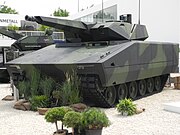
The Lynx KF41 was unveiled at Eurosatory.

Front right three-quarter shot of the Lynx KF41.

Lynx KF41 specifications

Inside of the Lynx IFV

The cut view 30x173mm ABM ammunition and its programming coil
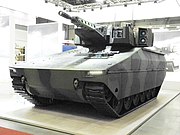
Front view of the Lynx KF31 as shown at IDET 2017 in the Czech Republic.

Lynx KF31 in Australian Army colours; the KF41 has been offered to Australia.

Rear three-quarter view of the Lynx KF31 as shown at IDET 2017 in the Czech Republic.

Lynx in reconnaissance configuration.
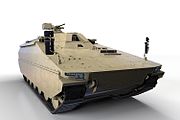
Lynx in armoured personnel carrier (APC) configuration.
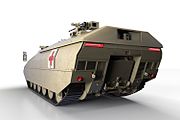
Lynx in ambulance configuration.
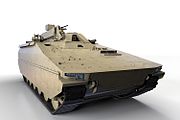
Lynx in repair and recovery configuration.

Lynx in command and control configuration.
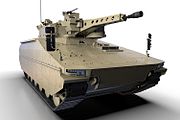
Lynx in infantry fighting vehicle configuration.
Operators[]
Future operators[]
 Hungary
Hungary- 218 vehicles on order. On 17 August 2020 the government of Hungary and Rheinmetall Group signed a contract to start manufacturing the Lynx infantry fighting vehicle family in Hungary. Few other details emerged at the time about the deal, which is part of Hungary’s Zrinyi 2026 rearmament programme launched in 2017. Hungarian Ministry of Defence sources stated to Janes on 19 August that the details of the package, including industrial and procurement aspects, would be worked out within one to two months.[17] In a 2 September 2020 interview about the new Lynx production joint venture and possible further German-Hungarian-Czech cooperation, Oliver Mittelsdorf, CEO of Rheinmetall Defence explicitly mentioned the existing, long-running manufacturing ties between Rheinmetall's MAN and Rába, a 124-years old Hungarian automotive manufacturing group with an active truck manufacturing plant near Győr, in Northwestern Hungary. A week later, on 10 September 2020 Rheinmetall and the Government of Hungary held a joint press conference in Budapest and among the details of the new joint manufacturing project they announced that the new factory, along with an almost three square kilometer-sized full-service vehicle test track called ZALA Zone, will be built near Zalaegerszeg, Hungary.[18][19][20] Rheinmetall's press release of 10 September 2020 confirmed that the Hungarian Ministry of Defence had awarded Rheinmetall an order to supply tracked armoured vehicles and related products and services with a total value of more than €2 billion. The contract covers 218 Lynx infantry fighting vehicles fitted with Rheinmetall's manned 30mm Lance turret. The larger/heavier Lynx KF41 has been selected by Hungary. The award also includes nine Leopard 2 based Buffalo armoured recovery vehicles, plus additional products and services that include simulators, training and instruction, plus an initial supply of spare parts as well as maintenance support.[7] During a first phase of production, Hungary is to receive forty-six Lynx plus the nine Buffalo ARVs, with delivery to be complete by the start of 2023. These vehicles will be built in Germany, but for the second production phase an additional 172 Lynx will be built in Hungary. To this end, it was confirmed the Hungarian government and Rheinmetall had agreed in August 2020 to establish a joint venture responsible for creating a Lynx production facility in Hungary, to be financed by a local company.[7]:A government document published in June 2021 talks about 256 Lynx IFVs being ordered. It also mentions the development and production of an air-defence variant using the Lynx chassis.[21]:The factory building near Zalaegerszeg is ready, the tooling is under installation, the production starts late 2022, early 2023 with a planned production rate of 50 Lynx vehicles / year. Rheinmetall are going to develop the following versions for the Hungarian Army:[22]
- Mortar Carrier with 120mm mortar - most likely using Hirtenberger's mortars as this company is owned by the Hungarian government.
- Ambulance
- C2/C3 vehicle
- Air Defence variant with autocannon (SPAAG) especially designed to counter drones (still in conceptual phase)
Potential operators[]
 Australia
Australia- Rheinmetall has submitted the Lynx KF41 for the Australian Defence Force's Land 400 Phase 3 program (also known as the Mounted Close Combat Capability), the Request for Tender (RFT) for which was released on 24 August 2018. Land 400 Phase 3 will replace the Australian Army's M113AS4 armoured personnel carriers (APCs) with up to 450 infantry fighting vehicles (IFVs) and 17 manoeuvre support vehicles.[4][23] In mid-September 2019, Rheinmetall's Lynx KF41 Infantry Fighting Vehicle (IFV) and Hanwha's Redback K21 IFV were shortlisted for consideration for the Australian Army’s project Land 400 Phase 3 and will provide prototypes for a risk mitigation activity.[24][9] Down-selection of a preferred tenderer that will be presented to the government for consideration is expected during 2022 and following that an initial operating capability of the selected platform is expected to be reached in 2024–2025, while final operating capability is expected by 2030–2031. Rheinmetall has also responded to a request for information on the procurement of another 117 vehicles under the Land 400 programme, these configured as logistics, mortar carries with direct fire capabilities, mortar ammo providers, and protected amphibious platforms.[9]
 Czech Republic
Czech Republic- Rheinmetall submitted the Lynx KF41 for the Army of the Czech Republic's (ACR's) program to replace its current BVP-2, a Czech produced version of BMP-2. In November 2017 the Czech MoD completed field tests of four tracked AFV finalists and planned to select a winning platform by mid-2018, awarding a CZK50 billion contract for a mixed batch of 210 platforms with initial deliveries to begin in 2020. The ACR were reportedly very satisfied with the Lynx.[25] In December 2018, Lynx was shortlisted together with the Puma, ASCOD and CV90.[26] In October 2019 it was announced that the Puma was being withdrawn from the competition. The manufacturer said that the Czech Army requirements would require an expensive redesign to the existing Puma which it was unwilling to undertake.[27] As of September 2020 no decision had been announced, however in March 2020 it was reported by Janes that the Czech MoD was preparing big cuts in defence spending as a result of COVID-19 and that the IFV award was threatened. On the 6th of November, 2021 Czech MoD announced that “none of the offers met all requirements”, no IFVs would be purchased.[28]
 Qatar
Qatar- In December 2018, a single Lynx KF41 was presented in the annual National Day parade badged and camouflaged as a Qatar Military Police (MP) vehicle. Rheinmetall declined to comment as to the nature of the vehicle’s presence at the parade.[9]
 Slovakia
Slovakia- The Slovak government plans to purchase 228 tracked AFVs by 2035. One of the contenders is Rheinmetall's Lynx IFV.[29]
 United States
United States- In October 2018, Rheinmetall announced a teaming with Raytheon to propose the Lynx KF41 to the U.S. Army in answer to its developing Next-Generation Combat Vehicle program, this slated to replace the Bradley Fighting Vehicles and other current platforms.[30] This program, now known as the Optionally Manned Fighting Vehicle program, was halted on 16 January 2020. The U.S. stated it was cancelling the OMFV prototyping competition in order to revisit the requirements and acquisition timeline.[9] The OMFV was subsequently re-started and in May 2020 Matthew Warnick, the American Rheinmetall Vehicles managing director stated that the Rheinmetall teaming would continue to compete in the revised OMFV requirement, however he added, “[Our proposal] is not going to be the Lynx in its current form, as everybody saw at [the AUSA conference] two years ago …This is going to be revised and evolved, based on the final RFP [request for proposal] but it’s a great starting point given its next-generation attributes to meet the specific US Army requirements.” The US Army is currently expected to release the OMFV RFP and at the start of FY 2022 to select vendors to produce digital designs. In the second quarter of FY 2023, the army will then decide which teams will proceed into the one-year detailed design phase. By the start of the second quarter of FY 2024, the service will conduct a critical design review and select the vendors to build OMFV prototypes with plans to begin testing these prototypes in the second half of FY 2025, before making a final down-select in FY 2027.[31] On 16 February Allison Transmission announced a strategic partnership with American Rheinmetall Vehicles to provide the company's Next-Generation Electrified Transmission (NGET) propulsion system for the OMFV Lynx.[32]
See also[]
References[]
- ^ a b "Rheinmetall Defence – News archive 2015 Rheinmetall's new IFV, the Lynx". www.rheinmetall-defence.com (Press release). Retrieved 2016-06-15.
- ^ "KF31 Lynx Rheinmetall IFV tracked Infantry Fighting Vehicle".
- ^ a b c d "Eurosatory 2018: Rheinmetall unveils Lynx KF41 IFV | IHS Jane's". www.janes.com. Retrieved 2018-06-24.
- ^ a b c "Rheinmetall's Lynx Infantry Vehicle Targets Australian Market". Defense News. 14 June 2016. Retrieved 2016-06-15.
- ^ "Lynx on the hunt [ES2016D3]". IHS Jane's 360. Retrieved 2016-06-15.
- ^ "Rheinmetall at Eurosatory (2018)". www.forecastinternational.com. 2018-06-04. Retrieved 2018-06-07.
- ^ a b c "NATO member Hungary orders 218 Lynx infantry fighting vehicles from Rheinmetall worth more than €2 billion". www.rheinmetall.com. 2020-09-10. Retrieved 2020-09-11.
- ^ a b c d e f g h i "Lynx Infantry Fighting Vehicle" (PDF). Defense Technology Review Magazine. 14 June 2016. Retrieved 14 June 2016.
- ^ a b c d e f "Lynx (Jane's AFVs 2019-2020)". IHS Jane's. Retrieved 2020-02-06.
- ^ a b c d e f g "Lynx (Jan 2018)". www.janes.com. 2017-06-09. Retrieved 2018-01-26.
- ^ a b c d "Rheinmetall undiscloses the Lynx Light Armored Infantry Fighting Vehicle at Eurosatory 2016". www.armyrecognition.com. 14 June 2016. Retrieved 2016-06-15.
- ^ a b c d e "Rheinmetall Defence – Lynx". Rheinmetall Defence.
- ^ "Lance 35".
- ^ "Rheinmetall intros new Lynx infantry fighting vehicle". UPI. 14 June 2016. Retrieved 2016-06-15.
- ^ "KF41 Lynx IFV Infantry Fighting Vehicle tracked armored data | Germany German army light armoured vehicle UK | Germany German army military equipment UK".
- ^ N, Leigh. "First KF41 Lynx in Australian Colours". Overt Defense.
{{cite web}}: CS1 maint: url-status (link) - ^ "Rheinmetall's Lynx Infantry Vehicle Targets Australian Market". Janes. 20 August 2020. Retrieved 2020-09-11.
- ^ "Hungary's Government and Rheinmetall to Produce Armored Fighting Vehicles in Hungary".
- ^ "218 harckocsit vesz a Magyar Honvédség". 24.hu (in Hungarian). 2020-09-09. Retrieved 2020-09-09.
- ^ "Šéf Rheinmettalu: Pokud někdo chce shodit tendr za 52 miliard na rozsahu hlavní zbraně, je to absurdní". ekonomickydenik.cz (in Czech). 2020-09-02. Retrieved 2020-09-09.
- ^ "Minutes of the Defence Commitee of the Parlament of Hungary, 8th of June, 2021" (PDF).
{{cite web}}: CS1 maint: url-status (link) - ^ "radio broadcast in Hungarian: Spirit FM Bázis-ugrás - 2022.01.26".
{{cite web}}: CS1 maint: url-status (link) - ^ "Australia issues tender for Land 400 Phase 3". www.janes.com. Retrieved 2018-08-30.
- ^ Risk mitigation contracts were signed in October 2019, and the activity is expected to conclude around the end of 2021.Rheinmetall and Hanwha shortlisted for Land 400 Phase 3, , 2019-09-16
- ^ "Key IFV decisions ahead for Czech MoD". www.janes.com. Retrieved 2018-01-26.
- ^ "Czech Republic; Four firms shortlisted in BVP armoured vehicle tender". Defense Market Intelligence. 19 December 2018. Archived from the original on 19 December 2018. Retrieved 19 December 2018.
- ^ Adamowski, Jaroslaw (18 October 2019). "Three bidders offer combat vehicles to Czech military, as German joint venture bows out". DefenseNews. Retrieved 20 October 2019.
- ^ "Czech Republic halts IFV buy as "none of the offers met all requirements"".
{{cite web}}: CS1 maint: url-status (link) - ^ "Slovakia plans to acquire new wheeled and tracked IFVs Infantry Fighting Vehicles".
{{cite web}}: CS1 maint: url-status (link) - ^ Judson, Jen (8 October 2018). "Raytheon, Rheinmetall partner to offer new Lynx fighting vehicle to US Army". Defense News. Washington. Archived from the original on 8 October 2018. Retrieved 8 October 2018.
- ^ "Lynx JAFV 2020". Janes. 23 May 2020. Retrieved 11 September 2020.
- ^ "Allison Transmission Partners with American Rheinmetall Vehicles to Produce the Propulsion System for Lynx OMFV Offering". allisontransmission. 16 February 2021. Retrieved 22 February 2021.
External links[]
| Wikimedia Commons has media related to Rheinmetall MAN Military Vehicles. |
- Rheinmetall
- Infantry fighting vehicles
- Tracked infantry fighting vehicles
- Armoured fighting vehicles of Germany














